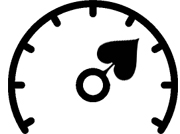 The Speed Count is another extremely simple and easy to understand blackjack card counting systems. It is the perfect system for card counting beginners to help gain an edge over the house.
The Speed Count is another extremely simple and easy to understand blackjack card counting systems. It is the perfect system for card counting beginners to help gain an edge over the house.
This system came about when Dan Pronovost decided to come up with an easier card counting system, one that anyone could learn and use without having to learn hours and hours of numbers and systems. The main reason was that there many that tried to learn, but implemented the Hi-Lo count wrong.
How It Works
The Speed Count, as mentioned above, is a very easy and simple card counting system; even simpler than the Ace-Five and Hi-Lo systems. It takes into account several different factors in order for it to work:
- Statistically there is an average of 2.7 cards to any completed blackjack hand. More players take three cards, than staying with two.
- High percent of low cards: 2, 3, 4, 5, and 6. There are 20 low cards for every 52 card deck, making up for 38% of each standard deck.
- With there being 5 small cards to every 13 big cards, there is an average of one card per hand, regardless of number of players, decks, etc.
You do not need to remember or learn any of this information, it was simply to let you know why the Speed Count works and ends up giving a player an advantage.
Steps to Using Speed Count
Keeping it as simple as possible, speed count relies only on the small cards, which include the 2’s, 3’s, 4’s, 5’s, and 6’s; all of which we have learned in other systems as being unfavorable for a player.
- Start with a count of zero with each new shoe that will be played. In other words, after the cards have been shuffled and placed in the shoe, start your zero count. If you enter a game midway through, we advise you wait until the round finishes.
- When all cards are dealt to the players and dealer, count the amount of small cards on the table. You will then use this number to make a small subtraction.
- To see whether the player has an advantage or not, they will take the small card count and divide it by the number of players (this includes the dealer). For example, if there are a total of 6 small cards, 3 players, and 1 dealer, it would work out to as: 6 – 4 = +2.
- If the count is positive, this means there are fewer low cards left in the shoe, statistically. If the count is negative, there is still a high amount of low cards in the shoe, making it unfavorable for the player.
- When the count is positive, the player can place higher bets, and vice versa when the count is negative.
- The player can keep the count after each hand, which he can then add or subtract from the next round of blackjack. However, it is not imperative that the player keep the exact count, unless there is a big gap: +4 or more, -3 or less.
This way, the players do not have to keep track of each card that is dealt, but rather just focus on the small cards, and make a simple subtraction. As this is not a complex system, the player advantage won’t be as high as some of the other card counting systems, but it could still give a player up to 1% edge over the house. The advantage is still greater than simply using basic blackjack strategy to play.





